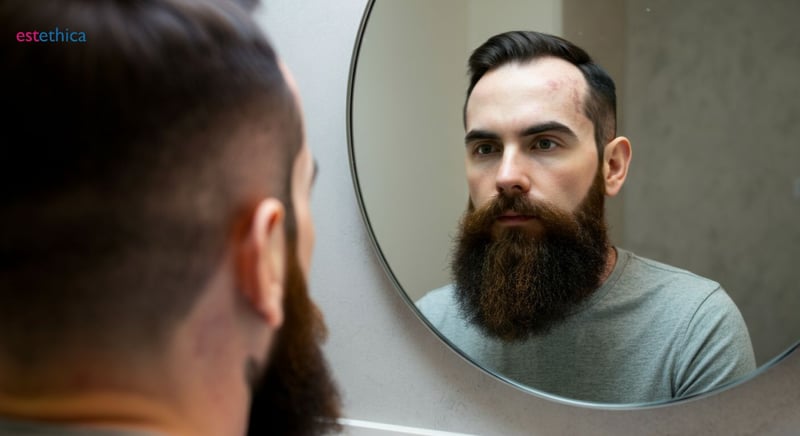Mastering Beard Transplants: Essential Insights Revealed
Explore groundbreaking beard transplant techniques and post-care tips.
Welcome to the ultimate guide on beard transplant success. In this blog, we delve into the intricacies of beard transplantation, offering insights into the top techniques, recovery expectations, and seasonal care tips. Whether you're curious about the process or planning your own procedure, our comprehensive resource compiles everything you need to know.
Understanding Beard Transplant: How It Works
Exploring Beard Transplant Techniques
The beard transplant process primarily involves two advanced techniques: Follicular Unit Extraction (FUE) and Direct Hair Implantation (DHI). FUE is a meticulous method where individual follicular units are extracted and implanted into the beard area, ensuring a natural look. In contrast, DHI employs a specialized pen-like device that extracts and implants follicles directly, often resulting in less scarring and a quicker recovery. These techniques are pivotal in achieving a seamless and natural beard appearance. Consulting with experienced professionals in reputable clinics is crucial for optimal results and minimizing risks.
Key Benefits of Beard Transplant Techniques
- FUE offers precision and natural results, ideal for detailed styling.
- DHI minimizes scarring and accelerates healing, enhancing patient comfort.
- Both techniques provide long-lasting solutions for facial hair restoration.
Understanding these techniques helps candidates choose the best approach for natural and satisfying results. For more insights, explore how beard transplants can transform your look.
Steps in the Beard Transplant Process
- Consultation: Assessing the beard area and determining the best technique.
- Extraction: Carefully removing hair follicles from the donor site.
- Implantation: Placing follicles in the beard area for a natural appearance.
Each step is crucial for achieving a successful beard transplant, ensuring both aesthetic appeal and patient satisfaction. By understanding these processes, individuals can make informed decisions about their facial hair restoration journey.

Top Techniques for Facial Hair Restoration
Innovative Approaches in Beard Transplantation
Facial hair restoration has seen remarkable advancements, with techniques like Follicular Unit Extraction (FUE) and Direct Hair Implantation (DHI) leading the way. FUE is celebrated for its precision, allowing surgeons to extract and implant individual follicles meticulously, creating dense and natural-looking beards. Meanwhile, DHI stands out for its ability to place hair directly at the desired angle and direction, closely mimicking natural growth patterns. These methods are pivotal in achieving seamless results, making them popular choices in beard transplant clinics.
Understanding Beard Transplant Price Factors
While specific pricing details are not discussed, several factors influence the overall cost of a beard transplant. These include the technique used, the extent of the area to be covered, and the expertise of the surgeon. Clinics like estethica, known for integrating innovative methods, offer comprehensive solutions that focus on quality and natural outcomes. Understanding these factors helps individuals make informed decisions about their facial hair restoration journey.
Complementary Treatments for Enhanced Results
- PRP Therapy: Enhances hair growth and accelerates recovery.
- Post-Transplant Care: Essential for maintaining transplant success.
- Regular Follow-Ups: Ensures optimal results and addresses any concerns.
Complementary treatments play a crucial role in the success of beard transplants. PRP (Platelet-Rich Plasma) therapy, for instance, is often used to nurture hair growth and speed up recovery. Post-transplant care and regular follow-ups are also vital to ensure the longevity and health of the transplanted hair. By integrating these treatments, clinics can offer a holistic approach to facial hair restoration.
Steps to Achieve Natural Beard Growth
- Consultation: Tailoring the approach to individual needs.
- Technique Selection: Choosing between FUE, DHI, or Sapphire FUE.
- Post-Procedure Care: Following guidelines for optimal healing.
Achieving natural beard growth through transplantation involves several key steps. Initially, a thorough consultation helps tailor the approach to the individual's needs. Selecting the appropriate technique, whether FUE, DHI, or Sapphire FUE, is crucial for achieving the desired results. Post-procedure care, including following specific guidelines, ensures optimal healing and the success of the transplant. These steps are integral to the facial hair restoration process, providing individuals with the confidence of a natural and lasting beard.

Navigating Recovery: What to Expect Post-Transplant
Understanding the Recovery Timeline
Post-transplant recovery is a pivotal phase that determines the success of a beard transplant. Initially, patients might experience minor swelling, redness, or soreness, which usually subsides within a week. It's essential to adhere to post-care instructions, including gentle washing techniques and avoiding direct sunlight. After the initial recovery, transplanted hair may shed as new growth begins. Full results typically manifest within six to twelve months. Continuous follow-up with the transplant clinic ensures complications are averted, and the new beard achieves its fullest potential.
Factors Influencing Beard Transplant Price
While specific pricing details are not discussed, several factors influence the overall cost of a beard transplant. These include the technique used, the extent of the area to be covered, and the expertise of the surgeon. Clinics like estethica, known for integrating innovative methods, offer comprehensive solutions that focus on quality and natural outcomes. Understanding these factors helps individuals make informed decisions about their facial hair restoration journey.
Essential Post-Transplant Care Tips
- Avoid direct sunlight to prevent irritation and promote healing.
- Use gentle washing techniques to maintain the integrity of the transplant.
- Follow clinic guidelines for optimal recovery and results.
Adhering to these post-transplant care tips is crucial for ensuring the success of the beard transplant. Avoiding direct sunlight helps prevent irritation, while gentle washing techniques maintain the integrity of the transplant. Following clinic guidelines ensures optimal recovery and results, allowing the new beard to achieve its fullest potential.
Steps for Monitoring Recovery Progress
- Regular follow-ups with the transplant clinic to monitor progress.
- Documenting changes and growth patterns for personal records.
- Adjusting care routines based on professional advice.
Monitoring recovery progress involves several key steps. Regular follow-ups with the transplant clinic are essential for tracking progress and addressing any concerns. Documenting changes and growth patterns helps individuals understand their recovery journey. Adjusting care routines based on professional advice ensures the best possible outcomes for the beard transplant.

Seasonal Care Tips for Your New Beard
Adapting Beard Care for Different Seasons
Seasonal changes require tailored care for your newly transplanted beard to ensure its health and vitality. In summer, the sun's intensity can lead to dryness, making hydration essential. Using SPF-infused beard oils protects against UV damage, maintaining the beard's luster. Conversely, winter demands a focus on combating dryness with nourishing oils and balms to keep both hair and skin moisturized. Regular grooming prevents ingrown hairs and maintains a neat appearance, crucial for a robust beard throughout the year. Clinics like estethica offer professional advice for season-specific beard care, ensuring your beard remains vibrant and healthy.
Factors Influencing Beard Transplant Price
While specific pricing details are not discussed, several factors influence the overall cost of a beard transplant. These include the technique used, the extent of the area to be covered, and the expertise of the surgeon. Clinics like estethica, known for integrating innovative methods, offer comprehensive solutions that focus on quality and natural outcomes. Understanding these factors helps individuals make informed decisions about their facial hair restoration journey.
Essential Seasonal Beard Care Tips
- Summer: Hydrate and use SPF-infused oils to protect against UV rays.
- Winter: Apply nourishing oils and balms to combat dryness.
- Year-round: Regular grooming to prevent ingrown hairs and maintain neatness.
These seasonal care tips are vital for maintaining the health and appearance of your transplanted beard. By adapting your routine to the changing seasons, you ensure that your beard remains vibrant and robust throughout the year.
Steps for Seasonal Beard Care Routine
- Assess seasonal needs: Identify specific challenges each season presents.
- Choose appropriate products: Select oils and balms suited for the season.
- Consult professionals: Seek advice from clinics like estethica for tailored care.
Implementing a seasonal beard care routine involves assessing the unique needs of each season, choosing suitable products, and consulting professionals for expert advice. This approach ensures your beard remains healthy and well-maintained year-round.
Advanced Techniques in Beard Transplantation
Excellence in Beard Transplant Process
Frequently Asked Questions
What are the main techniques used in beard transplantation?
What should I expect during the recovery phase after a beard transplant?
How do seasonal changes affect beard care after a transplant?
What are the benefits of complementary treatments like PRP therapy in beard transplants?
How do I choose the right technique for my beard transplant?
Discover the Art of Healthy Beauty with estethica! Call now for your free consultation and take the first step towards a new you.
📞 Call Us Today for Expert Advice